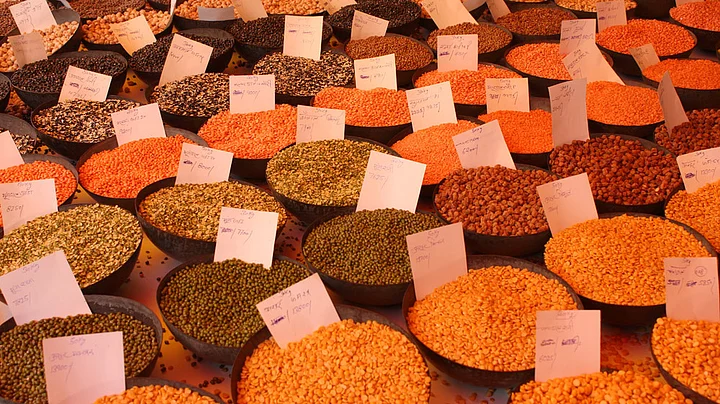Whimsical weather, adverse policies for farmers and perverse incentives to traders have caused prices of pulses, particularly of tur dal or pigeon pea, to soar despite record production in recent years.
Even long-time producers well versed with the agronomy of pigeon pea in Kanpur’s Dehat area in central Uttar Pradesh have shifted acreages to other crops following heavy losses triggered by hailstorms and heavy rains earlier this year. One farmer, the head of a pigeon pea seed production group in the district, could harvest just one quintal against the 25 quintal he had expected. This is confidence sapping. When a nine-month crop is lost, an entire year’s earnings have to be written off.
In Karnataka’s Gulbarga (now Kalaburagi) area, a pigeon pea hub, there was such a rush this sowing season that the local research station of an agricultural university ran out of seeds. But the absence of rainfall in July diminished ardour for the crop. September rains in the drought-hit Marathwada region of Maharashtra, on the other hand, have boosted the pigeon pea crop, which should mitigate to some extent the losses that farmers would have otherwise suffered.
But overall production from the monsoon season crop is expected to be 15 million tonnes short of the target of 70.5 million tonnes.
Drop in Pulse Production
With a 64 per cent share, India is the world’s largest producer of pigeon pea, which is the country’s second most consumed dal after chick pea or chana. Average productivity in the three years leading up to 2013-14 was 762 kg a hectare, which is close to the global average.
India’s pigeon pea yield has remained flat, despite 36 high yielding varieties being released since 1992. Hybrids have been developed – the first for a pulses crop – that have yielded about three tonnes a hectare in research farms, but that has been difficult to translate into output in farmers’ fields.
Output Figures Being Fudged?
Chick pea production, at nearly 10 million tonne,s has doubled over the past 10 years. Area under the crop has touched the 1959-60 peak. Chana has seen the release of the most number of high-yielding varieties – 89 – over the past 25 years. The development of the large-seeded kabuli chana is noteworthy. Small quantities of it are also being exported. The loss of four million hectares in north India over the years has been made up by central, western, and southern India as chana is not sensitive to light or heat.
About a million tonnes of moong dal have been produced from three million hectares. Since it can be harvested in about 60 days, it is seen as an opportunistic crop that fits into the rice-rice cycle of eastern India and the rice-wheat system of the north west. In fact, a three-crop system with moong as one component is recommended, as it enriches the soil with nitrogen which they absorb from the air.
Though production has grown handsomely it has been insufficient to meet demand. Some observers treat the output figures with scepticism as state agriculture departments are known to manipulate them. But they cannot be too off the mark.
Preventive Measures
- Intervention by the police is needed to prevent traders from profiteering by creating artificial shortages
- Need to incentivise the creation of storages so that farmers can benefit from higher prices when supply ebbs
- Bt gene which is insecticide resistant can be used in pigeon pea and chick pea as well
- A price stabilisation fund for pulses should keep soaring prices in check
Flawed Policy
Public policies have not been helpful for the cultivation of pulses. Though minimum support prices are announced, little procurement takes place, so farmers prefer to grow rice and wheat if they can. They also tend to treat pulses as peripheral crops. One or two supplementary irrigations can increase yield by 30-40 per cent, but are usually not given.
The fertiliser policy is discriminatory. Urea (nitrogen) is heavily subsidised. Pulses produce their own nitrogen. But the prices of fertilisers containing phosphorous and potassium, which pulses need, are sold at market prices which are beyond the reach of most farmers who grow them.
Pulses researchers say yields can rise by about a third if losses caused by the pod borer can be stemmed. A sure-fire way of doing this is through genetic engineering as resistance is not available in local varieties. The Bt gene that has produced insecticide resistance in cotton against bollworms can be used in pigeon pea and chick pea as well, but the government has not so far been open to allowing genetic modification of food crops (though public sector research institutions have invested in the technology).
What Needs to be Done
Whole pulses do not stay for long as they get infested with insects. Split dals have a longer shelf life but there is not enough storage facilities. The stocking limits which the government imposes to check hoarding discourages investment in warehouses, though police action is also needed to prevent traders from profiteering by creating artificial shortages.
There is a need to incentivise the creation of storage facilities like in the case of potatoes, where farmers can store their produce soon after harvest so they can benefit from higher prices when the supply ebbs. They should be able to borrow using warehouse receipts as collateral. A price stabilisation fund is a good idea; though government agencies tend to have feet cast in cement.
Pulses are the second largest item of food imports (by value) after cooking oil. Observers say that split yellow peas imported from Canada are mixed with chana dal and sold at a higher price. Eating joints, they say, pass it off as tur dal.
A number of steps need to be taken to raise domestic production of pulses and tame prices. But little long-term purposive action is evident.
(Vivian Fernandes is consulting editor with www.smartindianagriculture.in)
